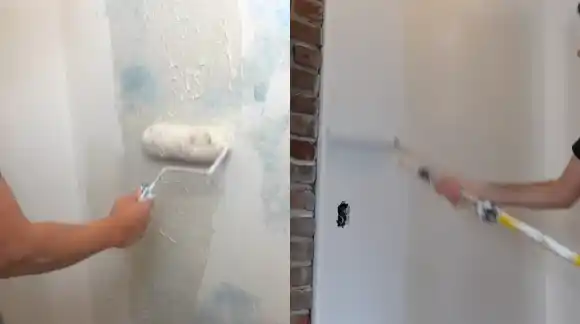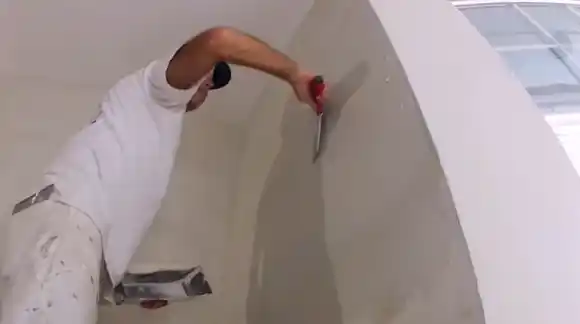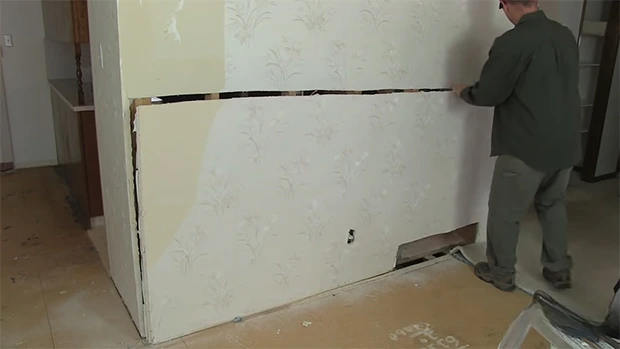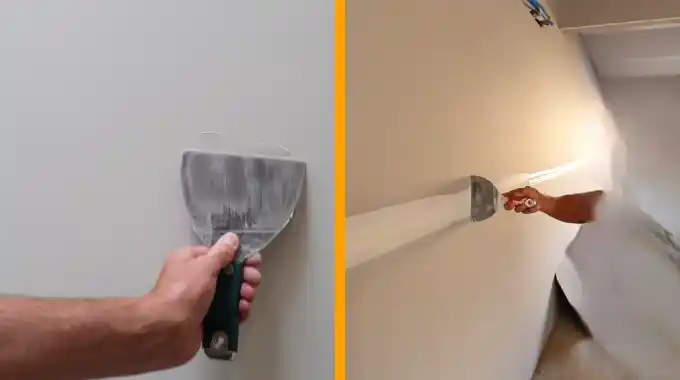Last Updated on July 27, 2023
Renovating a home is an exciting adventure, but there’s one critical choice to make along the way: skim coating or new drywall. Depending on your budget and existing wall condition, you can decide which route best fits your project.
Skim coating is an easy way to give old walls new life with a layer of fresh plaster. While installing new drywall allows for completely unspoiled results, although the work requires more effort.
Weighing up the advantages and disadvantages of each option based on the differences is crucial to get a superb outcome. Read on to find out how to prepare for either route and get tips on maximizing results with this guide.
Skim coat vs New Drywall: Recommended One for Renovating

Although Skim coating and installing new drywall have their unique benefits, some distinct differences between them should be taken into consideration before making a decision on which to use:
Damages Walls:
Skim coating is often used to repair minor drywall damage, such as hairline cracks or small holes in walls that need not be replaced entirely with new drywall.
The process involves using a thin layer of joint drywall compound to fill in voids or other minor imperfections and can be done relatively quickly compared to installing new drywall panels. A skim coat can also be applied to the entire drywall surface if the walls are in good shape and need refreshing.
On the other hand, replacing damaged walls with new drywall requires more time, supplies, and labor due to needing to cut out old panels, measure and cut new pieces, then attach them securely and finish up with drywall joint compound and taping.
Timeline:
Regarding completing a project, the skim coating process is much faster than replacing damaged drywall with new ones since it only requires one coat of plaster instead of multiple steps.
Also, this method allows you to quickly smooth out any imperfections in existing walls without putting up entirely new structures, making it a more convenient process.
Alternatively, if you need more repairs or renovations, installing new drywall will take a lot longer since each step must be carefully done to make sure it holds up against damage from daily life activities.
Difficulty:

Skim coating on damaged drywall might sound daunting for DIY newbies, but with patience and focus during the application, anyone can tackle the project like a pro. The key is to spread the plaster (AKA drywall mud) evenly. No gaps or rough patches allowed.
Installing beautiful new drywall sheets is a breeze as long as you’ve got some skills. From measuring accurately to ensuring that screws are correctly secured in wooden frames, having basic construction knowledge is key for adding those final touches needed for a secure drywall installation onto any wall surface.
Durability:
Regarding overall durability, the skim coating is great for covering up minor wall imperfections quickly, but if you need more lasting protection against bumps and impacts, installing a new sheetrock panel may be the better option.
New drywall or sheetrock over paneling also provides an extra layer of security since it’s secured directly onto your wall frame, which is way sturdier than skim alone.
If you’re worried about active kiddos and their playtime antics, it’s worth adding new, reinforced sheets for extra security. These provide greater rigidity from anchored fixings that stand up over time.
Ease of Installation
Installing a skim coat is much quicker than installing new drywall because it simply involves applying a thin layer of drywall mud on top of existing drywall with a trowel or sprayer.
When installing skim coats, it’s important not to apply too thick of a layer so that the skims coat doesn’t become too heavy and cause a bulge in the middle of the wall surface.
Unfortunately, when installing new drywall, it’s necessary to remove any old one and replace it with brand-new material, which can take much longer than simply adding a thin layer on top of the existing drywall. You may need another layer of drywall mud to seal and finish the new drywall.
You Might be Interested: Does stacked stone work with thinset?
Topics of Discussion: Is it necessary to water down the paint before spraying it?
Cost Efficiency
When comparing cost efficiency between skim coats & new drywall, it’s essential to consider both labor and material costs associated with each option.
Skim coating your walls is an attractive, wallet-friendly way to improve the look of any room. Instead of tearing out and replacing old drywall, this process adds a thin layer. So you get all the benefits without breaking the bank.
Regarding materials, skim coating only requires one type of material, whereas installing a new drywall necessitates buying multiple boards, which could add up quickly depending on the size of your project. Overall, the skim coating is the more cost-effective choice between the two methods.
What are the Advantages and Disadvantages of Skim Coats on Old Drywall?

The advantages and disadvantages of using a skim coat on old drywall will depend largely on the project’s scope and the desired outcome.
Advantages of Using Skim Coats on Old Damaged Drywall:
1. Skim coats provide an easy and efficient way to cover imperfections or blemishes on old drywall surfaces.
2. It provides a smooth, uniform surface ideal for painting, wallpapering, or other wall treatments.
3. A skim coat can help maintain the structural integrity of the existing drywall by filling in any cracks or holes that may have formed over time.
4. It helps reduce the dust on walls since it forms a more seamless surface with fewer nooks and crannies for dirt and dust to accumulate.
5. Skim coating old drywall can extend its lifespan by protecting it from further damage due to everyday wear and tear.
6. Applying a skim coat helps reduce sound transmission between rooms since it creates a more solid barrier between them.
Disadvantages of Using Skim Coats on Old Drywall:
1. Skim coating old drywall requires extra preparation, including cleaning, sanding, and sealing before application.
2. If not applied correctly, some areas may be left with bumps or ridges, needing additional attention to fix them properly.
3. Depending on how thickly you apply the skim coat, it may seem like you’re just adding an extra layer of material instead of fixing problems with your existing wall finish.
Advantages and Disadvantages of Installing New Drywall by Replacing an Old Drywall?

Replacing an old drywall with a new one has advantages and disadvantages, which should be weighed carefully before making the decision:
Advantages of Replacing Old Drywall With New Drywall:
1. Installing new drywall helps with energy efficiency as it creates a tight seal between the interior and exterior walls, preventing heat loss and reducing energy bills.
2. Replacing old drywall helps increase safety by creating barriers preventing the fire from spreading quickly throughout the building.
3. Since newly installed drywall is stronger than old ones, it can offer extra support when walls are subjected to heavy loads like furniture or appliances.
4. Replacing an old damaged drywall with a new one allows homeowners or offices to customize their shared living spaces according to their style and aesthetic preferences without compromising safety or structural integrity.
5. Adding insulation behind newly installed walls can help reduce noise transfer from room to room, providing additional soundproofing for peace.
Disadvantages of Replacing Old Damaged Drywall With New Drywall:
1. The cost of materials, labor, removal, and disposal can add up quickly if you replace an entire wall with new drywall rather than just patching up existing ones.
2. Removing existing walls is often messy since debris needs to be cleaned up afterward, and any outlets will need to be covered during demolition.
3. Installing new drywalls requires skill to be securely fastened together unless you are experienced in construction work or have hired professionals who know precisely what they’re doing.
Does Skim Coating Require Sanding on Old Drywall?

Yes, the skim coating requires sanding on old drywall. Using medium-high grit sandpaper such as 200 or 220 grit is essential. This ensures that the wall surface is completely smooth and free of any imperfections before painting.
The smoother the surface, the better your skim coat will turn out. Also, sanding helps to remove any existing layers of paint, wallpaper, or texture from the walls so that the new skim coat adheres better.
Should I Prepare the Old Drywall Before Skim Coating?
Yes, it is highly recommended that you prepare your old drywall before skim coating it. This preparation process should include cleaning the walls with an all-purpose cleaner to remove any dirt or dust, filling any cracks or holes with spackle, and then allowing this time to dry.
Once filled, you should sand down these areas until they are flush with the wall’s surface. After completing this step, you will be ready to apply your skim coat.
How Thin Can You Apply a Skim Coat on Old Drywall?
A thin layer of skim coat can be applied on old drywall, depending on how much coverage you need. Generally, it should be around one-quarter inch thick for a standard application. This should provide enough coverage without making your walls too heavy or unevenly surfaced.
Also, remember that as you apply your skim coat layer, you should keep an eye out for any imperfections to ensure that your final product looks even and professional when completed.
Is it Necessary to Prime the New Skim-coated Drywall?

Yes, it is necessary to prime & seal newly skim-coated drywall. Priming provides a seal that prevents moisture from seeping into the drywall, which can lead to mold and mildew growth.
It also helps to create a uniform surface for paint and wallpaper adhesives by filling in tiny pores in the drywall created during the skim coating process. Primers also add an extra layer of protection against staining and scuff marks, making them essential for any wall-covering project.
Also, primers provide an adhesive surface that allows the paint to adhere better and last longer, resulting in better overall coverage over time. Prepping freshly skim-coated walls with primer is essential for achieving the desired look and finish.
Skim Coat vs New Drywall: Which one is Recommended?
Skim coating and replacing drywall are two very different approaches when renovating walls in your home. Skim coating is less time-consuming than replacing the entire wall and can save money in many instances if the condition of your drywall is so bad.
It is also essential to consider the wall’s condition before deciding which route to take. If the old drywall is not in relatively good condition, then opting for new drywall is the better choice. Also, sanding and priming are necessary after applying a skim coat, while new drywall requires less preparation.
Ultimately, each specific project should be evaluated independently when deciding whether skim coating or replacing drywall is the best option based on your budget and the wall condition.



